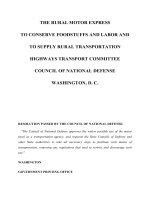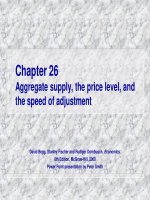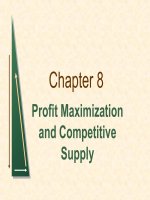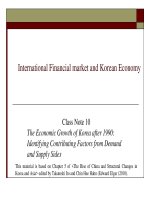33 aggregate demand and aggregate supply
Bạn đang xem bản rút gọn của tài liệu. Xem và tải ngay bản đầy đủ của tài liệu tại đây (210.86 KB, 7 trang )
CHAPTER 33
AGGREGATE DEMAND AND AGGREGATE SUPPLY
P754 – 755
1. Suppose the economy is in a long-run equilibrium
a.
b. A stock market crush causes aggregate demand to fall, then ADC shifts to
the left. Therefore, output (Y) decreases and price (P) decreases.
When the price level goes down, the aggregate supply decreases in
return. The firms decide to produce less goods and services. They might
hire less workers, which increases unemployment rate. Additionally,
employees in finance section might be laid off when the stock market
breaks. In both cases, unemployment rate rises.
c. Due to sticky-wage theory, the wage of workers does not increase in
respond to lower price. The firms will have to reduce production and cut
off workers. Over time as expectations adjust, the short-run aggregate
supply curve will shift to the right moving the economy back to the natural
rate of output.
2. Factors that shift the long-run aggregate supply curve: labor, capital, natural
resources, technology
a. Immigration increases the labor force, therefore increases the LRAS
b. An increase in minimum wage cause unemployment rate to rises. Less
labor causes LRAS to fall.
c. More powerful computer chips mean more advanced technology applied,
which increases LRAS.
d. A severe hurricane does not affect four factors of productions in long term,
then it has no effect on LRAS
3. Suppose an economy is in long-run equilibrium
a.
b. When money supply increases, the interest rate decreases (should be
more detailed), people have incentive to borrow more to invest. An
increase in investment will shift ADC to the right, which causes both price
level and output to surge.
c. At B, the actual price was higher than expected. When the economy
reaches this long-run equilibrium, the expected price level will have
adjusted to the actual price level. Nominal wage tends to increase. As a
result, the SAS curve will have shifted to the left till it crossed new
equilibrium of the intersection of AD2 and LAS
d. Price level increases from A to B, to C.
According to the sticky-wage theory, the nominal wage does not adjust to
changes in price instantaneously due to long-term contracts. Therefore,
nominal wages at point A is equal to nominal wages at point B.
In the long-run, the labor contracts will expire then nominal wages will
increase in respond to higher price at C.
e. According to the sticky-wage theory, the nominal wage does not adjust to
changes in price simultaneously due to long-term contracts. Therefore,
nominal wages at point A is equal to nominal wages at point B. However,
the price at B is higher at A, which means a person with the same wage
can buy less or his real wage is lower.
2
In the long-run, the wage adjusts to the higher price to remain purchasing
power of the wage, which means real wage at C is equal to real wage at A.
f. Previous analysis showed that money supply does affect the output in
short-run but not the output in long-run. Hence, it is consistent with the
precedent claim that money has real effects in the short-run but is neutral
in the long-run.
4. At the recession, the current equilibrium point was lower than the natural rate
as showed in the following model.
The president tried to prolong the shopping periods, which would raise
consumption and in turn, shift the AD to the right. The price level and output
would correspondently increase. The not yet fully recovered economy would
be boosted to natural rate.
5. Explain why the following statements are false:
a. The aggregate demand curve depicts the quantity of goods demanded in
the whole economy, where the microeconomic substitution from one
market to another is impossible. Therefore, the micro downward slope
demand curve explanation cannot be applied in this situation.
b. The long-run aggregate-supply curve is vertical because price level does
not affect long-run determinants of output (labor, capital, natural
resources, technology)
c. If firms adjust their prices every day, then the short-run aggregate-supply
curve would deviate less from vertical long-run ASC.
Meanwhile, a horizontal SAS means the output increase continuously at a
fixed price.
d. An economy recession is possibly because SAS or AD has shifted to left.
6. For each of the three theories for the upwards slope of the short-run AS
curve, explain the following:
a. How the economy recovers from a recession and returns to its long-run
equilibrium without any policy intervention?
According to the sticky-wage theory, when the economy is in a
recession, the output demand is lower than natural rate and
unemployment is higher than natural rate. Over time, as to avoid
unemployment, nominal wages tend to decline, business is less costly
then production will increase, SAS will shift to the right. The economy
returns to natural rate of output and full employment.
According to the sticky-price theory, the economy is in a recession
because not all prices adjust quickly. Over time, firms are able to adjust
their prices more fully, and the economy returns to the long-run
aggregate supply curve.
3
According to the misperceptions theory, the economy is in a recession
when the price level is below what was expected. Over time, as people
observe the lower price level, their expectations adjust, and the
economy returns to the long-run aggregate supply curve.
b. What determines the speed of that recovery?
How quick nominal wages adjust, price level adjusts and expectations
adjust. The more flexible the economy is, the quicker it recovers.
7. Money supply increase leads to lower interest rate, more borrowings and
investments and shifts the AD to the right. At the same, because the public
expected this action, the prices expected also rise and the AS shifts to the
left. Based on ADAS model, the output will change insignificant while price
level rises at C.
If the public doesn’t change its expectation in the price level, AD still shifts to
the right and SAS stays. Both the output and the price will increase to B.
8. The economy begins in long-run equilibrium
a. With appearance of a new president of FED with little concern about
inflation, loosened control of inflation is expected. In other words, higher
price level is conceived to prevail.
b. The nominal wages will be higher in respond to higher level price in new
labor contract.
c. A rise in nominal wages will increase the cost and make the business less
profitable at any given price level.
d. SAS will in turn shift to left as firms decide to produce less.
e. Meanwhile, AD is held constant. ASAD applied, the output will decrease
and the price level will increase from A to B.
4
f.
The appointment might not be a good one due to its predicted short-run
negative effects by ADAS model.
9. Explain shifts in AS or AD and their effects through ADAS model
a. Households decide to save a larger share of their income then the
quantity of goods and services demanded at any prices is lower. The AD
shifts to the left. Both the output and price level decrease.
b. Florida orange groves suffer a prolonged period of below-freezing
temperature.
This event makes productions costlier and less profitable. The firms might
cut off the production and AS shifts to the left. Output decreases and price
level increases.
c. Increased job opportunities overseas cause many people to leave the
country.
This event possibly drives down quantity demanded at any price level and
shifts the AD to the left. Both the output and price level decreases.
10.Explaining effects on long-run, short-run output, price level.
a. The stock market declines sharply, reducing consumer’s wealth. This
causes both consumption and investment to decrease and shifts the AD to
the left. In the short-run, both the output and price decrease at B. In the
long-run, as expected price level adjusts, the AS shifts to the right. The
price level continues to decrease but the output goes back to natural rate
at new equilibrium point C.
5
b. The federal government increases spending on national defense.
This event shifts the AD to the right. In the short-run, both output and
price level increase. In the long-run, as expected prices increases, the SAS
shifts to the left, the price level continues to increases but the output goes
back to natural rate.
c. A technological improvement raises productivity.
This events shifts both LAS and SAS to right while AD stays. In short-run,
output increases and price level decreases. In the long-run, output
increases and price level decreases as well.
d. A recession overseas causes foreigners to buy fewer U.S goods
This event shifts the AD to the left. In the short-run, both the output and
price decrease. In the long-run, as expected price level adjusts, the AS
shifts to the right. The recession deteriorates and AD shifts back to right.
The output goes back to natural rate.
11.Suppose firms become very optimistic about future business.
a. Heavy investment in new capital equipment shifts AD to the right. Both
the real output and price level increase from A to B or equilibrium moves
along SASC. In short-run, due to
sticky-wage theory: more profitable to produce
sticky-price theory: some firms can sell more because their price
was lower than current level, they will produce more
misperception theory: some producers misunderstand that their
products’ relative prices have increase then they produce more
All these factors make aggregate quantity of output supplied rise from its natural
rate from Y to Y1.
6
b. In the long-run, higher price level from A to B drives down the aggregate
quantity demanded through wealth effect, interest effect, exchange rate
effect. (equilibrium moves along ADC)
c. An investment boom might lead to capital improvement and increase
productivity, thereby increase aggregate quantity supplied in the long-run.
The LAS will shift to the right.
12.In economy A, nominal wages of all workers are completely sticky while in
economy B, nominal wages are half sticky.
Thereby, nominal wages in economy B is less stick and the its SAD is
steeper. A 5% increase in money supply will increase the aggregate
quantity demand, which rises the price level and output. Because price
level in economy A is sticker, it rises lesser than in economy B. At lower
new price, the quantity demanded in economy A is higher than in
economy B. In short, money supply has larger impact on output in
economy A, larger impact on price level in economy B.
7









